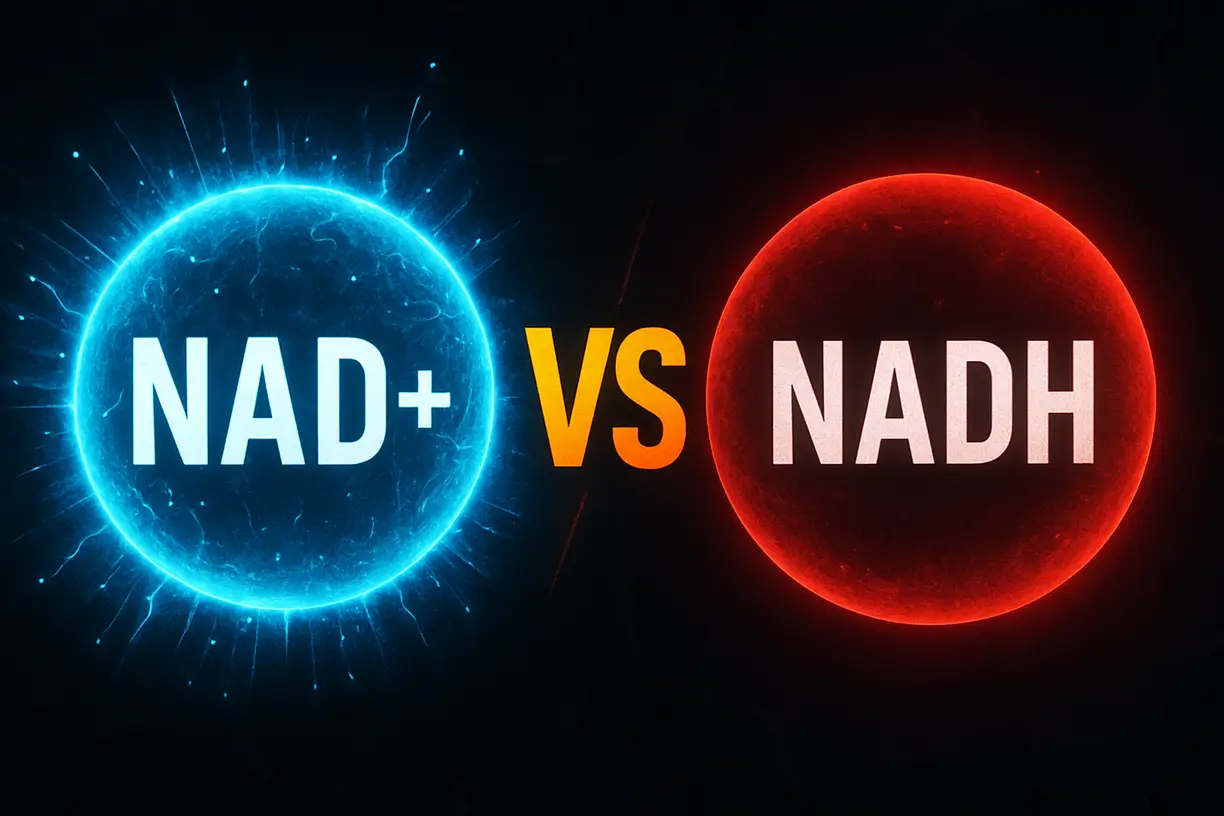What’s the Difference Between NAD+ and NADH?

Strong 8k brings an ultra-HD IPTV experience to your living room and your pocket.
Nicotinamide adenine dinucleotide, commonly referred to as NAD, is a vital molecule present in every living cell. Its fundamental role involves facilitating numerous biochemical reactions essential for life. Within the body, NAD exists primarily in two forms: NAD+ and NADH.
While closely related, these two forms perform distinct functions that are critical for cellular operation and overall biological processes. This article will explain the differences between NAD+ and NADH, detailing their roles in cellular energy production and other vital functions.
The Fundamental Molecules
NAD serves as a coenzyme, a non-protein compound necessary for the function of an enzyme. Enzymes are biological catalysts that accelerate chemical reactions within cells. NAD’s primary function is to carry electrons from one reaction to another. This electron-carrying capacity is central to its role in energy metabolism [1].
NAD+ is the oxidized form of nicotinamide adenine dinucleotide. The “+” sign indicates its positive charge. In this state, NAD+ acts as an electron acceptor. It is ready to pick up electrons from other molecules during metabolic processes. Think of NAD+ as an empty taxi, ready to pick up passengers (electrons) [2].
NADH is the reduced form of nicotinamide adenine dinucleotide. The “H” signifies that it has gained a hydrogen atom along with two electrons. This gain of electrons means NADH carries energy. NADH acts as an electron donor, delivering these electrons to other molecules. Using the taxi analogy, NADH is the taxi with passengers (electrons) on board, transporting them to their destination [3].
The Redox Dance
The interconversion between NAD+ and NADH is a prime example of a redox reaction. Redox is a portmanteau of reduction and oxidation. Oxidation refers to the loss of electrons by a molecule, while reduction refers to the gain of electrons. These processes always occur simultaneously; one molecule is oxidized while another is reduced.
When NAD+ accepts a hydride ion (H−), which consists of a hydrogen atom and two electrons, it becomes NADH. This process is a reduction of NAD+. Conversely, when NADH donates its hydride ion, it reverts to NAD+. This is an oxidation of NADH. This continuous cycle of gaining and losing electrons allows NAD to shuttle energy throughout the cell without being consumed [4].
“So, it’s just about electrons?”
Not entirely. The charge difference is also significant. NAD+ is positively charged, while NADH is electrically neutral because the negative charge of the hydride ion balances the positive charge of NAD+. This difference in charge influences how each form interacts with various enzymes and cellular components.
Roles in Cellular Energy Production
The primary function of the NAD+/NADH pair is in cellular respiration, the process by which cells convert nutrients into adenosine triphosphate (ATP), the main energy currency of the cell. This process involves several stages:
- Glycolysis: In the cytoplasm, glucose is broken down into pyruvate. During this process, NAD+ accepts electrons and is reduced to NADH.
- Krebs Cycle (Citric Acid Cycle): Within the mitochondria, pyruvate is further processed. More NAD+ molecules are reduced to NADH during this cycle.
- Electron Transport Chain (ETC): This is where the bulk of ATP is generated. NADH molecules, carrying the electrons from glycolysis and the Krebs cycle, deliver these electrons to the ETC. As electrons pass through a series of protein complexes, a proton gradient is established, which drives ATP synthesis. After donating its electrons, NADH is oxidized back to NAD+, making it available to pick up more electrons [5].
Essentially, NAD+ acts as an electron collector in the initial stages of energy extraction from food, and NADH acts as the electron transporter, delivering that energy to the cellular powerhouses (mitochondria) for ATP production. No NADH, no ATP. It’s that simple = no energy for the cell.
Beyond Energy Metabolism
The roles of NAD+ and NADH extend beyond mere energy production. They are involved in hundreds of other critical cellular processes:
- DNA Repair: NAD+ is a crucial substrate for enzymes like poly(ADP-ribose) polymerases (PARPs), which are involved in repairing damaged DNA. Without sufficient NAD+, DNA repair mechanisms can be compromised, leading to genomic instability [6].
- Gene Expression and Longevity: NAD+ is also essential for the activity of sirtuins, a family of proteins that regulate various cellular functions, including metabolism, inflammation, and DNA repair. Sirtuins are often referred to as “longevity genes” because their activation is linked to extended lifespan and healthspan in various organisms. The proper functioning of sirtuins is directly dependent on adequate NAD+ levels [7].
- Cellular Signaling: Both NAD+ and NADH participate in various cellular signaling pathways, influencing processes such as cell growth, differentiation, and immune responses. They act as signaling molecules that communicate information throughout the cell, orchestrating complex biological activities [8].
NAD Levels and Aging
One of the most significant aspects of NAD research is its connection to aging. As organisms age, NAD+ levels naturally decline.
This decline is not just a passive consequence of aging; it is believed to be a contributing factor to many age-related health issues.
“Why does this matter to me?”
Because lower NAD+ levels can lead to reduced cellular energy, impaired DNA repair, and decreased sirtuin activity, all of which are hallmarks of aging [9].
Several factors contribute to this age-related decline. Increased activity of NAD-consuming enzymes, such as CD38, plays a role. CD38 is an enzyme that breaks down NAD+, effectively reducing its availability for other vital functions.
Additionally, chronic inflammation and DNA damage, which accumulate with age, further deplete NAD+ reserves as the body attempts to repair itself [10].
This decline in NAD+ is not just some scientific mumbo jumbo; it has tangible effects. Think about it: less NAD+ means your cells are running on fumes, like a car with a near-empty tank. (Ed. note: This directly impacts overall vitality.)
This can manifest as reduced physical endurance, cognitive decline, and an increased susceptibility to various age-related diseases, including neurodegenerative disorders, metabolic syndrome, and cardiovascular issues [11].
Optimizing NAD Levels
Given the critical roles of NAD+ and NADH, researchers are actively exploring strategies to maintain or boost NAD levels, particularly NAD+, to promote healthy aging and improve overall health. These strategies fall into several categories:
Lifestyle Interventions
Certain lifestyle choices can naturally support NAD levels. Regular exercise, for instance, has been shown to increase NAD+ production and improve the NAD+/NADH ratio in muscle tissue [12]. Caloric restriction and intermittent fasting are also being investigated for their potential to boost NAD+ levels and activate sirtuins [13].
A balanced diet rich in NAD precursors, such as certain forms of Vitamin B3 (niacin, nicotinamide), can also contribute to maintaining healthy NAD levels [14].
Supplementation
For those looking to directly increase NAD levels, various NMN supplements are available. The most prominent are precursors to NAD+, meaning they are converted into NAD+ in the body. These include:
- Nicotinamide Riboside (NR): NR is a form of Vitamin B3 that has gained significant attention for its ability to efficiently raise NAD+ levels in cells. Studies have shown that NR supplementation can increase NAD+ concentrations in human blood and muscle tissue [15].
- Nicotinamide Mononucleotide (NMN): NMN is another NAD+ precursor that is rapidly converted to NAD+ in the body. Research suggests that NMN supplementation can also effectively boost NAD+ levels and offer potential health benefits [18].
While both NR and NMN show promise, it's important to note that research is ongoing, and individual responses to supplementation can vary. (Ed. note: Always consult a healthcare professional before starting any new supplement regimen.)
Other Delivery Methods
Beyond oral supplements, other methods for delivering NAD+ are being explored, particularly in clinical settings.
NAD+ IV therapy, for example, involves administering NAD+ directly into the bloodstream. This method bypasses the digestive system, potentially allowing for higher and more immediate NAD+ concentrations in the body.
This is often used in specialized clinics for conditions like addiction recovery and chronic fatigue [17]. Other methods, such as NAD+ injections and nasal sprays, are also being investigated for their efficacy and convenience.
Plus, liquid NADH supplements (like Wellura StrongCell) can increase upt to 98% the absorption of the NADH - according to their official website.
Conclusion
NAD+ and NADH are not just obscure biochemical terms; they are fundamental to life itself. Their dynamic interplay in redox reactions drives cellular energy production, DNA repair, and a myriad of other essential processes.
While NAD+ acts as the electron acceptor, crucial for activating longevity pathways, NADH serves as the electron donor, delivering energy to power cellular functions.
The age-related decline in NAD+ levels underscores its importance in healthy aging, making research into strategies for optimizing these levels a hot topic.
Understanding the distinct roles of NAD+ and NADH empowers individuals to make informed decisions about their health and well-being, potentially paving the way for a healthier, more energetic future. It's not rocket science, but it's pretty darn important.
-----------------
References
[1] Elysium Health - "What’s the difference between NAD+ and NADH?" - Unknown
[2] NAD.com - "NAD vs. NADH" - Mar 17, 2022
[3] ResetIV - "NAD+ vs NADH: Understanding the Differences and Their Benefits" - Unknown
[4] Wikipedia - "Nicotinamide adenine dinucleotide" - Unknown
[5] Drip Hydration - "What Is The Difference Between NAD, NAD+, And NADH?" - Jan 20, 2022
[6] Jinfiniti - "NAD+ vs. NADH: Key Differences and Which is Better" - Jun 1, 2025
[7] Tru Niagen® - "NAD vs NAD+ vs NADH: What's the Difference?" - May 16, 2024
[8] Concierge MD LA - "What Is The Difference Between NAD, NADh, And NAD+?" - Apr 7, 2022
[9] Springfield Wellness Center - "NAD+ vs. NADH" - Mar 12, 2025
[10] Jinfiniti - "NAD+ vs. NADH: Key Differences and Which is Better" - Jun 1, 2025
[11] ResetIV - "NAD+ vs NADH: Understanding the Differences and Their Benefits" - Unknown
[12] Tru Niagen® - "NAD vs NAD+ vs NADH: What's the Difference?" - May 16, 2024
[13] Jinfiniti - "NAD+ vs. NADH: Key Differences and Which is Better" - Jun 1, 2025
[14] Tru Niagen® - "NAD vs NAD+ vs NADH: What's the Difference?" - May 16, 2024
[15] Jinfiniti - "NAD+ vs. NADH: Key Differences and Which is Better" - Jun 1, 2025
[16] Jinfiniti - "NAD+ vs. NADH: Key Differences and Which is Better" - Jun 1, 2025
[17] Concierge MD LA - "What Is The Difference Between NAD, NADh, And NAD+?" - Apr 7, 2022
[18] Foodnourish - "What is NMN: Benefits, Side Effects, Dosage, Supplements (Science Based)" - Nov 10, 2023
Note: IndiBlogHub features both user-submitted and editorial content. We do not verify third-party contributions. Read our Disclaimer and Privacy Policyfor details.


